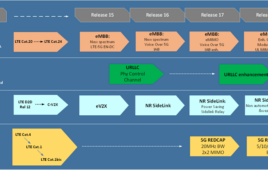The economy threw a wrench in many expectations for 2008.
While many analysts are combing their data for future prognostications, we decided to take a look back at some of the hot-button issues of 2008. Did the gloves finally come off in the LTE vs. WiMAX standoff? Did Android change the landscape of the handset market? Did femtocells make an impact?
The prevailing downfall of this past year’s predictions was (surprise, surprise) the unpredictable economy. The storm on Wall Street left many new technologies and initiatives, along with a fleet of analyst predictions, in a holding pattern.
LTE vs. WiMAX
Many analysts predicted a war between LTE and WiMAX, but few were ready to pick a winner. In the end, inCode made good with its prediction that the long-awaited showdown would not occur because WiMAX and LTE are in different stages of development. Rob Prudhomme, vice president of Practice Development at inCode, suggested that the two technologies will co-exist for some time. “Convergence makes sense, but they’re just not there yet,” he said. In other words, this isn’t looking like a 1980s, winner-take-all VHS vs. Beta contest.
Although greenfield WiMAX is being commercially rolled out now, LTE will evolve from a carrier’s existing infrastructure, which many LTE supporters say makes it more cost-effective. Prudhomme cited global companies like Alcatel-Lucent that want the option of choosing between the two technologies based on specific markets. For instance, India’s current infrastructure may be ripe for adoption of WiMAX, while more established markets with an existing infrastructure may be better suited for LTE.
Prudhomme stressed that the opportunity for convergence is not far off and may ultimately drive both markets. “Chipset development will be key,” he said. “You could see a chip that will handle both by late 2010.” For now, however, soft launches and trials will leave end-users salivating over what could and probably will be coming to a market near them.
Nigel Wright, vice president of product marketing at Spirent Communications, probably hit the nail on the head in a January 2008 article: “In all likelihood, many devices of the future will ship with both LTE and WiMAX capability… Consumers will probably not even know which particular technology is delivering high-speed data to them and they’re hardly likely to care, so long as it works to their satisfaction, and the content provided is engaging and available at the right price.” In conclusion, the gloves may be off in favor of shaking hands.
Femtocells
Last year saw a lot of opinions about femtocells. From declarations of both pariah to savior, analysts ran the gambit on what these nifty little devices could do for both consumers and carriers. In 2008, Jose Costa e Silva, CEO of Gigaset, predicted the death of femtocells to Total Telecom. “Femtocells will die after a short while because there isn’t a business case,” he said, favoring WiMAX as the forerunner in creating the wireless home experience.
But lack of a business case wasn’t enough to keep the rest of the world from endless chatter about the femtocell, and neither the chatter nor the devices are showing signs of dying off anytime soon. The femtocell proposition is one that sounded, and still sounds, like a win-win for both consumers and carriers. The consumer gets better reception. The carrier gets a cheap solution for backhaul.
A big obstacle standing in the way of femtocell deployment is standardization. “Carriers do not want to lock themselves into a single-vendor contract. They can’t if they want to be competitive,” said Dean Bubley, founder of Disruptive Analysis. Most analysts believe femtocells will be subsidized by carriers, which means carriers will have a direct interest in dealing with multiple vendors as a way of keeping prices down. That means standardization. Although femtocells probably were hurt by an unclear business case, they’re getting some help from the Third Generation Partnership Project (3GPP), which just rolled out baseline stages 2 and 3 femtocell specifications at this year’s 3GPP plenary.
Perhaps learning from the uncertainties of 2008, Prudhomme is cautious in his femtocell timeline. “The coming year could set the stage for an explosion in 2010,” he said. “But you never know.”
Mobile Advertising
With the prevalence of smartphones and data plans skyrocketing, wireless advertising was widely predicted to be the next big revenue driver in 2008. A study by Juniper Research in March 2008 signaled growth, projecting annual mobile search ad spend will reach $2 billion by 2013. The rise of more rich media phones will make the mobile market more attractive to both advertisers and consumers.
But on the whole, mobile advertising felt a multitude of growing pains. A host of issues, from privacy, regulation and standardization concerns to a bad economy, all contributed to this sector’s slower-than-expected growth.
If nothing else, mobile advertising saw a surge in innovation. Companies are employing technologies to target ultra-specific demographics at ultra-specific times and places (i.e., the oft-used example of a 30-something customer walking by Starbucks gets a coupon for a cup of coffee). Bad economy or not, it’s a good bet that analysts will again be heralding the coming of a new revenue driver in mobile advertising for 2009.
Handsets
A number of analysts predicted a return to the basic, durable and reliable cell phone. With buzz circulating at the end of 2007 about the iPhone 3G and Android, a prediction in favor of voice-centric phones was akin to predicting 100 inches of rain in the Mojave. But might there have been some signs of a back-to-basics market opening in 2008?
Regardless of the iPhone’s popularity, the handset market will always include a large percentage of voice-centric users who just want to make a phone call. “My dad had one of the first digital phones,” Prudhomme said. “He loved it for the big buttons…hung onto it as long as he could.” His father probably is not the only senior that doesn’t need or want an Inspector Gadget cell phone. In fact, a recent NPD Group survey found that 45% of U.S. cell phone users only use their devices to make phone calls.
“The basic phone that works whenever and wherever … is a value proposition that becomes much more important for consumers looking to simply make phone calls and save money,” Prudhomme said. Contrary to Prudhomme’s prediction, the third quarter saw significant percentage increases in almost all areas of advanced handset functionality, according to the NPD Group. Perhaps this is due to a steady standardization of some of the more advanced phone features. Given the spike in sales that typically accompanies the release of a new smartphone, fourth-quarter results, which include holiday gift-giving, may determine whether the back-to-basics logic pans out.
Android
The locked iPhone 3G had every gizmo-crazed techie looking for the wide open future promised by Android. Bubley wasn’t necessarily surprised by the reality of the phone or the platform. “It ain’t gonna change the world in 2008,” he wrote in December 2007. Given analyst and user reactions, that statement looks to have been accurate.
“I’m wary,” Bubley said of Android. “Frankly, it doesn’t appear to have captured the end-user the way the iPhone has.” He also wonders if Google really fancies competing with established companies like Nokia and Apple during a recession when the future of suppliers and manufacturers could be uncertain. “Google has enough money, though,” he said. “If they can ride it out through the downturn, who knows, maybe they’ll have something that can compete.”
Maybe Next Year
So went the year of a coulda-shoulda-woulda economy. Few things, save for bailouts and foreclosures, came to fruition. Perhaps all those analysts huddling over their crystal balls can be comforted by the words of Danish physicist Niels Bohr, who said: “Prediction is very difficult, especially if it’s about the future.”




